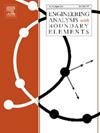热传导问题中使用 NMM 和 WOA-BP 协同神经网络进行孔识别的合并方法
IF 4.1
2区 工程技术
Q1 ENGINEERING, MULTIDISCIPLINARY
Engineering Analysis with Boundary Elements
Pub Date : 2024-11-13
DOI:10.1016/j.enganabound.2024.106042
引用次数: 0
摘要
缺陷识别是结构健康监测中的一个重要问题。本文从反演技术出发,建立了数值流形法(NMM)与鲸鱼优化算法-反向传播(WOA-BP)合作神经网络的融合方法,以识别热传导问题中的孔洞缺陷。一方面,数值流形法可以在固定的数学覆盖面上模拟不同的孔构造,这在很大程度上简化了神经网络训练所需的 "大数据 "的生成。另一方面,采用全局优化算法 WOA 来优化 BP 神经网络的初始权值和阈值,以缓解其经常出现的局部最优现象。利用 NMM 采样点的边界温度和相关的孔几何形状来学习 WOA-BP 神经网络,然后将其用于预测孔缺陷。有关圆形/椭圆形孔洞检测的数值实例表明,在相同条件下,与标准 BP 网络相比,所提出的方法在孔洞预测方面具有更高的准确性和令人满意的鲁棒性。本研究为结构健康监测的应用提供了便捷的途径和巨大的潜力。本文章由计算机程序翻译,如有差异,请以英文原文为准。
A merging approach for hole identification with the NMM and WOA-BP cooperative neural network in heat conduction problem
Defect identification is an important issue in structural health monitoring. Herein, originated from inverse techniques, a merging approach is established by the numerical manifold method (NMM) and whale optimization algorithm-back propagation (WOA-BP) cooperative neural network to identify hole defects in heat conduction problems. On the one hand, the NMM can simulate varying hole configurations on a fixed mathematical cover, which eases the generation of “big data” for the training of neural network to a large extent. On the other hand, the WOA, a global optimization algorithm, is adopted to optimize the initial weights and thresholds of the BP neural network to alleviate its frequently encountered local optimum phenomenon. The boundary temperatures of sampling points by the NMM and the associated hole geometries are used for the learning of WOA-BP neural network, which is then applied to predict the hole defects. Numerical examples concerning the detection of circular/ elliptical holes demonstrate that the proposed method possesses higher accuracy and satisfying robustness in holes prediction compared with standard BP network under the same condition. The present work provides a convenient pathway and great potential in application of structural health monitoring.
求助全文
通过发布文献求助,成功后即可免费获取论文全文。
去求助
来源期刊

Engineering Analysis with Boundary Elements
工程技术-工程:综合
CiteScore
5.50
自引率
18.20%
发文量
368
审稿时长
56 days
期刊介绍:
This journal is specifically dedicated to the dissemination of the latest developments of new engineering analysis techniques using boundary elements and other mesh reduction methods.
Boundary element (BEM) and mesh reduction methods (MRM) are very active areas of research with the techniques being applied to solve increasingly complex problems. The journal stresses the importance of these applications as well as their computational aspects, reliability and robustness.
The main criteria for publication will be the originality of the work being reported, its potential usefulness and applications of the methods to new fields.
In addition to regular issues, the journal publishes a series of special issues dealing with specific areas of current research.
The journal has, for many years, provided a channel of communication between academics and industrial researchers working in mesh reduction methods
Fields Covered:
• Boundary Element Methods (BEM)
• Mesh Reduction Methods (MRM)
• Meshless Methods
• Integral Equations
• Applications of BEM/MRM in Engineering
• Numerical Methods related to BEM/MRM
• Computational Techniques
• Combination of Different Methods
• Advanced Formulations.
 求助内容:
求助内容: 应助结果提醒方式:
应助结果提醒方式:


